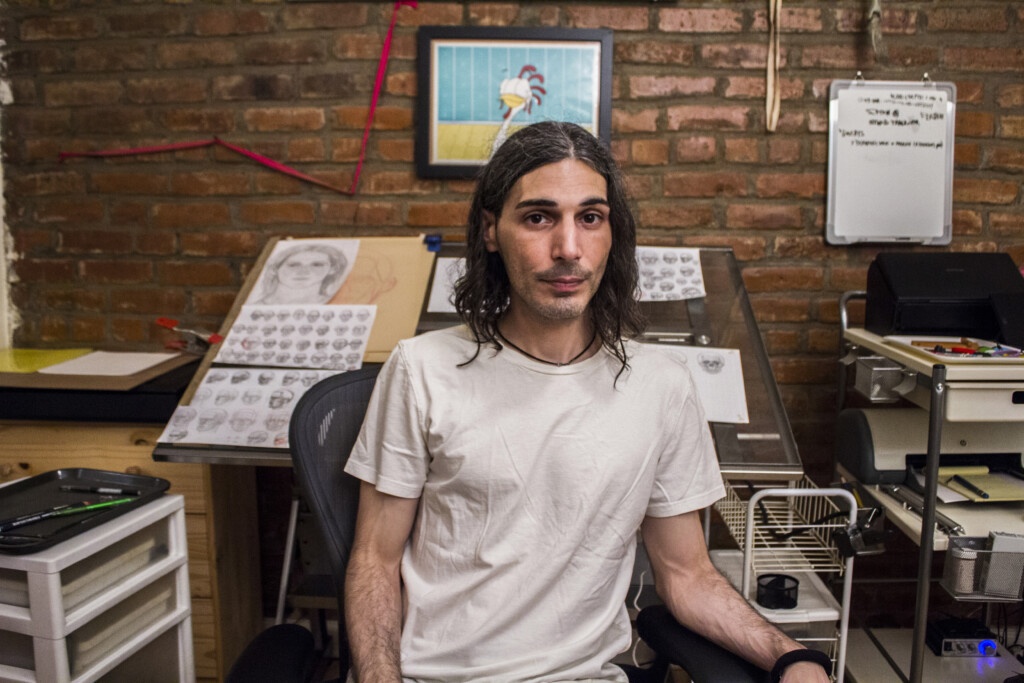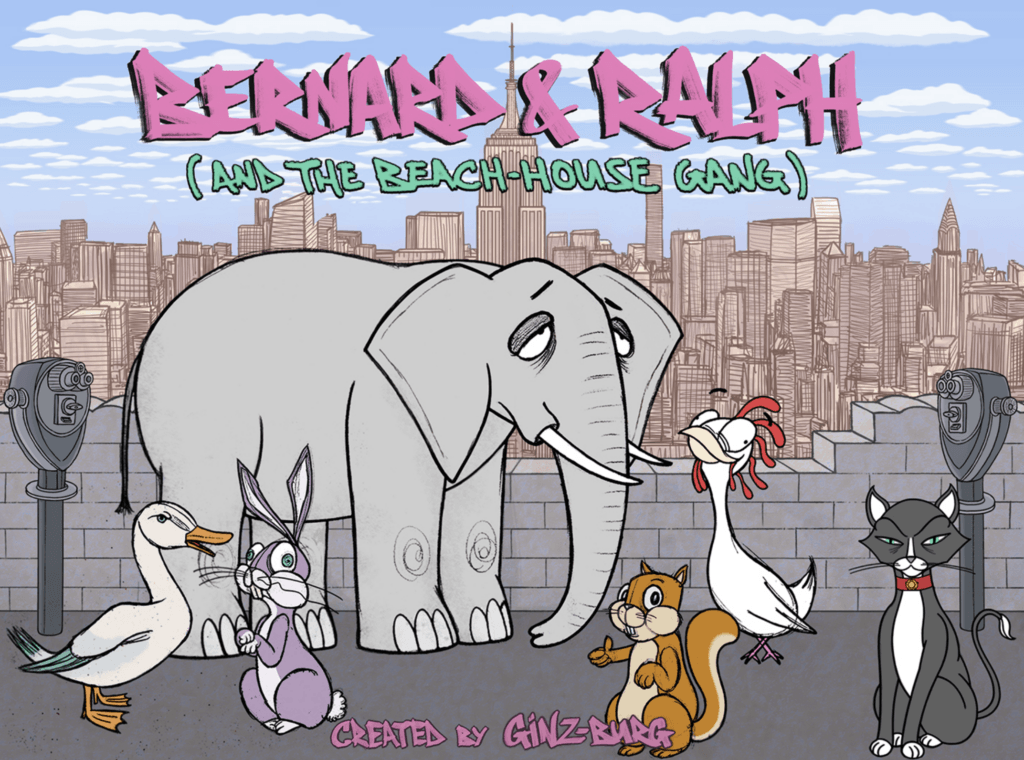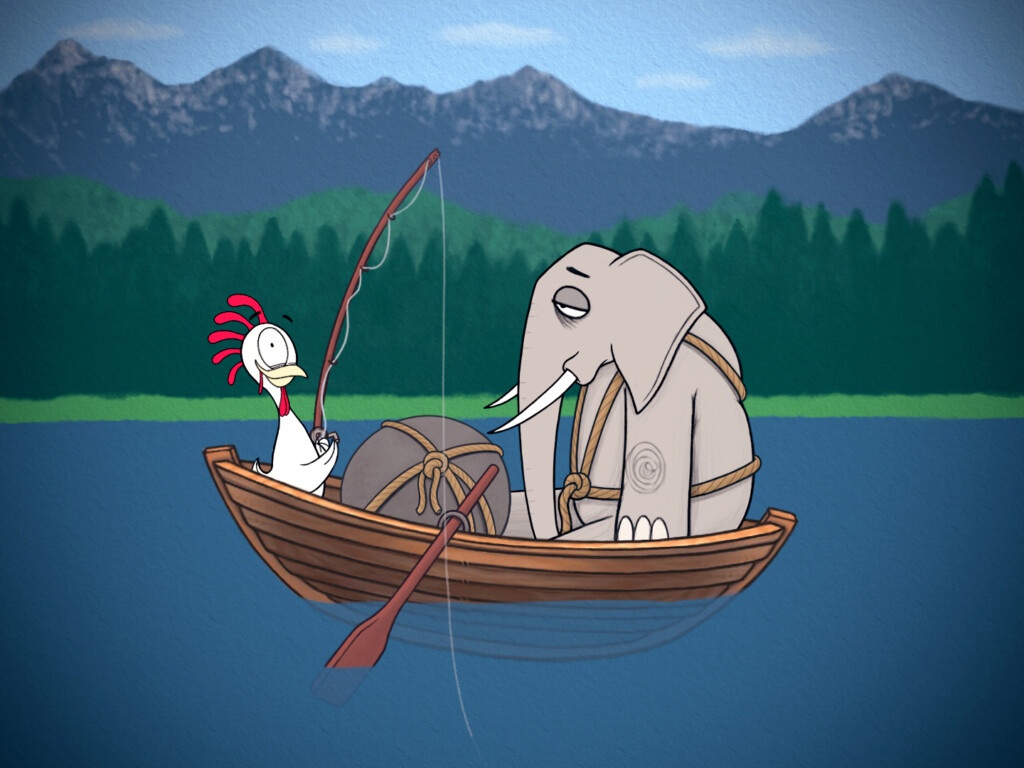August 8, 2022 – Hollywood, CA. ———————Daniel Dover has established a career built on ingenuity, versatility, and his relentless attitude, which always kept him at the vanguard of his numerous mediums of choice. Whether it’s his wit and humor, technical prowess, or anything in between, Dover has plenty of rabbits in his hat to make his artistic undertakings successful. Dover has been compared to many famous street and visual artists; Banksy, Ron English, Tristan Eaton, and Basquiat, just to name a few. His eclectic styles say a lot about his creative journey, from exhibiting in his hometown of Tel Aviv, across Europe, and all the way to his current home in New York City, which he adores for all that it has to offer. Needless to say, he knows what it takes to make it in America.
When asked where he gets his inspiration from, Dover says, “It usually comes from weird interactions I see around me – the more awkward, the better. I try not to take myself too seriously, so I let my humor lead the way”. Daniel Dover’s sense of humor, much like his personality, is very sincere, direct, and self-aware, all qualities that can be seen throughout his long list of projects. He doesn’t want the accolades that come with being famous, to him it’s all about the work.
Part conceptual, part theory, Daniel Dover’s art comes from deep within his psyche. His most recent labor of love is his animated show, ‘Bernard & Ralph – and The Beach-House Gang’, which he created, produced, and published under the pen name ‘Ginz-Burg’. The show follows a group of dysfunctional animals, each representing various mental and social disorders, as they attempt to get their lives back on track while living together in a communal halfway house.
Although the show deals with rather sensitive topics, such as depression, social isolation, and other mental issues, its humorous tone and quirky characters make these themes approachable for the viewer. This setting also provides a positive environment in which to engage with these subjects and examine them in a different light, ultimately offering an opportunity for catharsis.
Daniel Dover is continuing to produce ‘Bernard & Ralph – and The Beach-House Gang’ as a series of cartoon shorts, as well as actively working towards opportunities to turn it into a longer-form show. Dover is also developing several other cartoon show concepts, while also continuing to communicate with studios, as he’s always itching to bring his innovative arsenal of characters to life on a variety of platforms.
Daniel Dover’s current work in animation is a direct extension of the attitudes he embodied when he started his artistic career. In 2007, his street art series of gas-masked characters began to surface around Tel Aviv. Within the next two years, he became identified with a wide range of urban interventions, and his street art images grew increasingly diverse. One such artistic undertaking was his conception and painting of the animated escalators inside the entrance of Tel Aviv’s City Hall. Dover’s playful piece hit the internet and immediately went viral, and has also remained in commission to this day.
After moving to New York, Dover shifted his focus to animation projects, while still exhibiting his artwork in many various forms, with shows in Tel-Aviv, around Europe, and New York City. No matter the place, format, or subject, everything adds up to one prolific artist, willing to go the distance and do what it takes to bring his artwork to the forefront of his field. Whether it’s using spray paint, ink, ready-made sculpture or other media, Daniel Dover is a master of creating a visually sharp statement that projects a fragile truth about complex human and social systems. His work has been reviewed in many prestigious publications; Huffington Post, The LA Times, European Pressphoto Agency, The Guardian, and many more.
With such a wide range of exciting projects, it’s hard to know when and where Daniel Dover’s art will turn up next. This self-proclaimed workaholic has reinvented himself time and time again, and plans on providing his followers with many more surprises in the near future. His star sparkles proudly, and those in the know are collecting. Whether he’s painting art on the escalators at City Hall, curating a plastic zoo, or animating lovable eccentric characters, Daniel Dover’s art has no limits.
Daniel Dover:
Bernard & Ralph – and the Beach-House Gang – ‘Empire-State Elephant’
###
Schedule your interview with Daniel Dover now!
Media Inquiries:
Jodi Jackson
JJ Entertainment
323-356-0797
Daniel Dover Q & A:
What is it that you love about your job?
DD: Everything. I love coming up with silly ideas and seeing how far I can go with them. Since it’s hard for anyone to take these seriously, it is then my responsibility to somehow implement and produce them, just so I can prove they really work.
What are your first memories of any Visual Artists that you loved?
DD: My first memories are a little vague, but when I first moved to the maternity ward after being born – I think there was a lovely Monet reproduction hanging in the hallway. It looked a bit too spotty so I couldn’t make out all the details, probably on account of my eyesight still readjusting to the outside world.
After that, mostly renaissance paintings; super detailed stories in one frame, high contrast lighting and darkness, free anatomy lessons – and best of all, lots of blood and violence. How can you go wrong with that? It’s the full package.
Why did you want to become a Visual Artist/Animator?
DD: It simply seemed like the best and quickest way to get attention. Also, I had a knack for good depth perception on account of being half-blind in one eye (it’s fine now).
If you were not an animator – what business would you be in?
DD: Sound engineering always attracted me a lot, as it’s also ridiculously laborious work and usually goes unrewarded for the most part, so the switch would come pretty naturally I suppose. Also, I really like playing with lots of buttons and switchboards.
What is your favorite cartoon?
DD: The Ren & Stimpy Show. It used to air just before bedtime when I was growing up, best nightmares ever.
Who are your favorite artists?
DD: Norman Rockwell, Edward Sorel, Ralph Steadman, Friedensreich Hundertwasser, Egon Schiele, and like a few billion others.
Who are your favorite animators?
DD: Tex Avery, Chuck Jones, and Max Fleischer.
What is your favorite type of animation?
DD: Traditional 2D animation, preferably on celluloid or wrinkly paper.
What advice would you give someone just starting out in the business?
DD: Runnnnn!!!
Was there something pivotal in your life that changed the trajectory of your career?
DD: In my first year at kindergarten we were told to illustrate the story of a traditional holiday that was coming up. I continued to draw well after most kids had already exhausted their concentration, and when my mom came to pick me up, the teacher pulled her aside and said she was worried. Apparently, I was spending too much time on the task, and for some reason, I was drawing proportional characters with fingers instead of simple stick figures, which deeply concerned her. It felt nice to freak someone out using only pencil and paper, and I guess that’s when I knew what I wanted to do when I grew up.
How does being an Artist in New York City differ from anywhere else?
DD: Aside from the constant stream of inspiration coming from every direction, I find the hectic nature of the city really helps to keep one motivated, often to madness and obscene amounts of work hours, but still very productive nonetheless. Also, the paint is cheaper and the commissions are higher. It really is a win-win.
Do you have any favorite artists in New York?
DD: Edward Sorel, and Bill Plympton
Do you have any favorite artists in Israel?
DD: The New Barbizon Collective, and Maya Bloch.
What is a typical work day for you?
DD: Pretty much never-ending. My daily schedule varies by project. I try to keep a healthy routine of around 10 to12 hour workdays for the most part. During the mid-to-final stretch of a project, it usually deteriorates pretty quickly into 14 to 17-hour workdays. I also happen to like coffee a lot.
How do you see your career going in the next 5 years?
DD: I want to keep producing ‘Bernard & Ralph – and The Beach-House Gang’ as cartoon shorts, in hopes of turning it into a longer-form show given the opportunity. I would also like to keep developing several other cartoon show concepts I’ve been working on lately, ranging from bizarre adult cartoons to more traditional psychedelic stuff for kids.
What’s the funniest thing that happened to you while you were in your creative process?
DD: I think almost everything that happens is funny to me during the creative process. That’s just basically what it is, having fun with silly ideas, and then finding a way to implement them in a relevant and meaningful way, which is sometimes less funny, but still kind of necessary.
What is the most joyous time you have had so far in your career?
DD: Generally every time period where I was working non-stop. One of my favorites was definitely during the time I used to do street art around Tel-Aviv. It was kind of refreshing to get out of the studio for a while and breathe some fresh spray paint, and also fun since I got to hang out with friends and do a lot of physical exercise.
What’s your favorite thing about living in New York?
DD: Walking around the city streets and picking up funny ideas from weird and crazy sights along the way. I kind of like the weather too.
What’s your favorite color palette?
DD: I really like pop-y, desaturated palettes, like pastel pink, faded yellow, and sea-foam green. I just find it fits well with almost everything.
How does new technology affect you as an artist/animator?
DD: It doesn’t really; I still like traditional techniques for the most part. I already spent all this time learning them, might as well put them to use.
What’s your process as an artist?
DD: Neatly chaotic. When working on my own projects, the process does usually start with a silly idea or a joke. At certain times it’s immediately clear how to implement it as a visual image or the basis for a more comprehensive project. If not, I’ll tend to keep it as a note in my folders, in case it comes in handy for a different silly idea or future project.
What’s your process as an animator?
DD: Basically the same, but much more laborious. The joke really needs to be funny in order for me to get motivated enough to animate it. If it is, I work in a pretty traditional way; writing the story (if there is one), sketching out the shots and key poses in thumbnails, creating a preliminary soundtrack plus voices, and then hopefully not losing hope before I start fully animating the whole thing.
Where do you get the inspiration for your artwork?
DD: The issue for me is more about how to focus and decide on which inspirational whim I want to follow. There are endless sources really, varying from other visual artists, music, film, cartoons, or just weird human interactions all around.
Do you ever collaborate on any of your projects?
DD: I do try to keep a healthy diet of some collaborative work every now and then, as it gets a little tedious only working by myself all the time. Occasionally it’s fun to only do the design work if someone has a great concept that I connect with, and can find some way to contribute to.
How do you find your work?
DD: When it comes to my own projects, I usually just start doing them, and then hopefully find what to do with them along the way. In the freelance aspect, it’s usually word of mouth or someone who liked an older project and reached out.
What is your work ethic like?
DD: I really love what I do, so I dedicate myself to my work in a ridiculously unbalanced fashion, which is just the way I like it. I only wish I could do just a little bit more.
How did you get your start as an artist?
DD: After college, I was studying traditional animation by myself for a few months and wanted to take a short break before completely losing my mind indoors. I thought it would be a fun change to quickly do a little street art project I had previously planned, and things kind of took off from there.
Do you have a mentor in the business?
DD: I’ve had a few mentors over the years, mostly in regards to feedback about concepts and ideas for their implementation and production.
What kind of skill set does it take to be a visual artist?
DD: In my opinion; an original sense of aesthetics, good depth of field perception, and knowing how to tell a story or describe a certain feeling, whether in one frame or a bunch of them running fast (not too fast though, 24fps is just fine).
What kind of skills does it take to be an animator?
DD: Mostly dedication and keeping track of the frame count. Self-flagellation and tendencies for extreme isolation can also be valuable assets.
What influence did your siblings have on you?
DD: As the youngest of three brothers, I pretty much learned everything about culture and comedy from my siblings, tasteless as it was. When I started drawing more inspiration from other sources around me, I would still run it by them for quality control purposes and then try to gather feedback, a very merciless process I continue to this day.
Why did you want to move to the US?
DD: I always wanted to live in New York. When I first visited as a child and saw the Warner Brothers store on 57th street, it was kind of a done deal for me. Also, great jazz clubs.
What cities have you traveled to?
DD: I spent a lot of time traveling around Europe before moving to New York, so quite a bunch. Lucerne is probably the prettiest place I’ve ever visited, but it does get quite boring after 6:45 pm.
Define your style.
DD: All over the place, yet somehow still consistent and repetitive.
What would you say influenced you the most in your career trajectory?
DD: Definitely watching too many cartoons. In the first 15 to 18 years of my life, it seemed like a waste of time to the outside observer, but I finally proved them wrong.
How do you find your drive?
DD: During long midnight conversations with my guilty conscience.
What are your health regimes?
DD: Surprisingly strict. After losing function of my hand during a grueling period of overworking myself, I really had no choice but to start taking care of my body in a more responsible way. It’s quite awful and time-consuming, but seeing as I need my hand to complete most work, it’s unfortunately kind of necessary.
What kind of research do you do before a project?
DD: Endless. In most cases I like to use as much reference as possible and delve as deeply as I can into the world I’m about to visualize. Daydreaming comes in very handy during such periods of work.
Are you a good role model to others on your team?
DD: Yes, the best. Since I mostly work alone, it is up to me to push myself as hard as humanly possible. I think that’s a pretty good role model for myself if I may say so.
What types of meetings do you take before you start a project?
DD: In cases of freelance work, briefings, and brainstorming; and as much as possible. I like to gather as much information as I can to fully immerse myself in a project. Kind of like method actors but with less drama and weight-transformations.
Are you very hands-on?
DD: Extremely so, I’m ambidextrous. I even tried to animate an entire episode once using my feet, though it came out kind of wobbly, and also my pencils smelled a bit funny later.
Are you involved with a project from the very start?
DD: That is definitely the ideal case for me, as I like to work on development from the very first stages whenever possible. If it’s an interesting project that’s already in progress, I would certainly need to feel like I can actually contribute something meaningful, and hopefully not just be a session player.
What types of material do you use to make an art piece?
DD: I like to use a very wide variety of mediums, as I find the concept dictates the form in many cases. Pencils and paper will always be my go-to, with ink and watercolors coming in second place.
How long does it take you typically to complete an art piece?
DD: Hopefully around 3 to 14 days. Anything after that usually becomes muddy and incomprehensible.
How long does it take you to complete a project?
DD: It very much depends on the nature of the project, ideally around 8 to 12 weeks. The last one took 8 to 9 months, so it’s not exactly a precise science.
What has been your favorite project that you have worked on?
DD: ‘Bernard & Ralph – and The Beach-House Gang’. While also by far the most grueling one, it was a decade-long dream to produce, so I took great joy in every miserable moment.
Are you proud of your work?
DD: Almost always, at least somewhat, but it really depends.
A buffer time period usually helps. I’ll often be dismayed by technical stuff I could and should have probably done better, but as far as subject matters and ideas go, I’m pretty content.
What museums do you like to go to in New York?
DD: The Metropolitan Museum is always hours of endless fun, but the Museum of Natural history gets the win because they have bigger dinosaurs.















